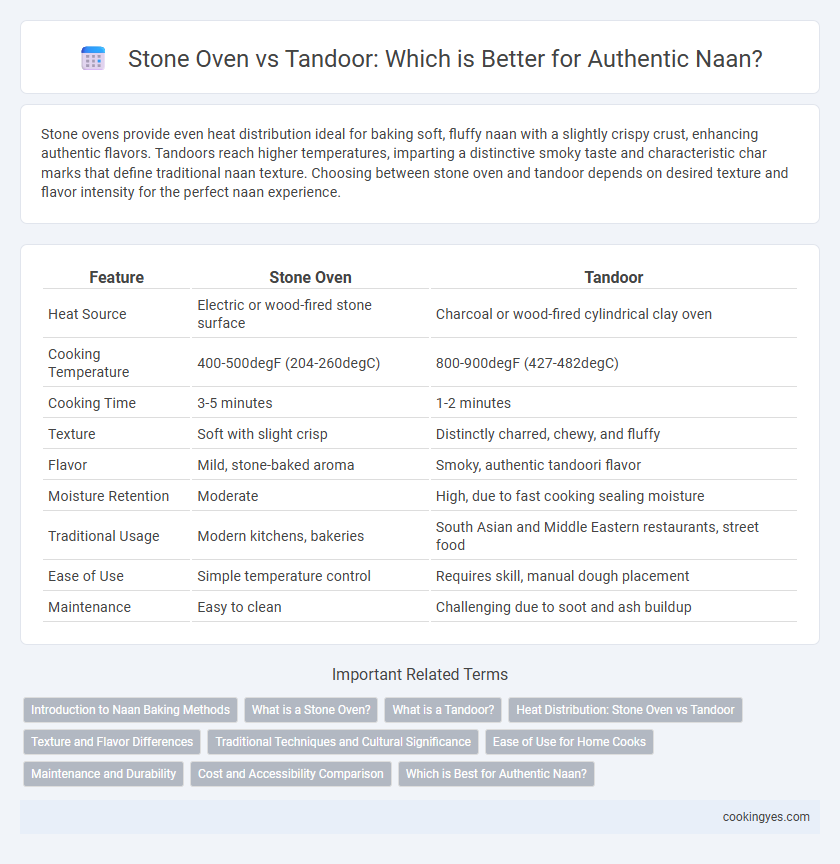Stone ovens provide even heat distribution ideal for baking soft, fluffy naan with a slightly crispy crust, enhancing authentic flavors. Tandoors reach higher temperatures, imparting a distinctive smoky taste and characteristic char marks that define traditional naan texture. Choosing between stone oven and tandoor depends on desired texture and flavor intensity for the perfect naan experience.
Table of Comparison
| Feature | Stone Oven | Tandoor |
|---|---|---|
| Heat Source | Electric or wood-fired stone surface | Charcoal or wood-fired cylindrical clay oven |
| Cooking Temperature | 400-500degF (204-260degC) | 800-900degF (427-482degC) |
| Cooking Time | 3-5 minutes | 1-2 minutes |
| Texture | Soft with slight crisp | Distinctly charred, chewy, and fluffy |
| Flavor | Mild, stone-baked aroma | Smoky, authentic tandoori flavor |
| Moisture Retention | Moderate | High, due to fast cooking sealing moisture |
| Traditional Usage | Modern kitchens, bakeries | South Asian and Middle Eastern restaurants, street food |
| Ease of Use | Simple temperature control | Requires skill, manual dough placement |
| Maintenance | Easy to clean | Challenging due to soot and ash buildup |
Introduction to Naan Baking Methods
Naan baking methods primarily include stone oven and tandoor techniques, each impacting texture and flavor uniquely. Stone ovens provide even heat distribution, resulting in a crisp exterior and soft interior, while tandoors offer intense direct heat, imparting a characteristic smoky aroma and slightly charred spots. Understanding these methods is essential for mastering authentic naan preparation and achieving desired culinary qualities.
What is a Stone Oven?
A stone oven is a traditional baking chamber constructed from heat-retaining materials such as bricks or natural stones, designed to maintain high, even temperatures ideal for baking naan. Unlike a tandoor, which is a cylindrical clay or metal oven that uses direct radiant heat and fire, the stone oven relies on the heat absorbed and radiated by its stone surfaces to cook the dough evenly. This results in a distinct texture and flavor in naan, characterized by a crispy exterior and soft, airy interior.
What is a Tandoor?
A tandoor is a traditional cylindrical clay or metal oven heated with charcoal or wood, reaching temperatures up to 900degF (480degC), ideal for baking authentic naan bread. The intense heat and unique cooking environment create a distinct smoky flavor and characteristic charred spots on the naan. Unlike stone ovens, tandoors allow the dough to be slapped directly onto the inner walls, resulting in rapid cooking and a soft, airy texture.
Heat Distribution: Stone Oven vs Tandoor
Stone ovens provide a more even and consistent heat distribution, allowing naan to cook uniformly without hot spots. Tandoors generate extreme, radiant heat from all sides, creating a unique char and fluffiness but may result in uneven cooking if not expertly managed. Both ovens impact naan's texture and taste through their distinctive methods of heat transfer and retention.
Texture and Flavor Differences
Naan baked in a stone oven develops a slightly crispy exterior with a softer, more uniform crumb, while tandoor-cooked naan features charred, smoky spots and a chewier texture due to intense radiant heat. The tandoor's high temperature and direct contact with the clay walls impart a distinctive smoky flavor and blistered surface, enhancing the bread's rustic appeal. Stone ovens provide even heat distribution, resulting in a milder flavor profile that highlights the dough's natural sweetness.
Traditional Techniques and Cultural Significance
Naan has traditionally been baked in a tandoor, a cylindrical clay oven that imparts a unique smoky flavor and characteristic charred spots, reflecting centuries-old culinary practices in South Asia. Stone ovens, while used in some regions, often lack the intense heat and even cooking environment of a tandoor, resulting in a different texture and flavor profile. The tandoor's cultural significance extends beyond its function, symbolizing communal cooking and traditional craftsmanship passed through generations.
Ease of Use for Home Cooks
Stone ovens offer greater ease of use for home cooks making naan, requiring minimal setup and simpler temperature control compared to traditional tandoors. Tandoors, often needing specialized fuel and higher skill to maintain consistent heat, present a steeper learning curve. For convenience and accessibility, stone ovens provide a practical alternative without sacrificing the authentic naan texture.
Maintenance and Durability
Stone ovens offer easier maintenance due to their simple construction and heat retention properties, requiring less frequent cleaning and repairs compared to tandoors. Tandoors, traditionally made from clay, demand regular maintenance to prevent cracks and ensure durability under high temperatures. The durability of stone ovens generally exceeds tandoors, making them a long-lasting option for consistent naan baking.
Cost and Accessibility Comparison
Stone ovens for naan are generally more affordable and widely accessible, making them a practical choice for small restaurants and home kitchens. Tandoors involve higher initial costs due to specialized construction and fuel requirements, often limiting their use to dedicated Indian eateries. Availability of stone ovens in various sizes and their compatibility with multiple fuel sources enhance their cost-effectiveness and accessibility compared to the traditional tandoor.
Which is Best for Authentic Naan?
Tandoor ovens, traditionally made from clay and heated with charcoal or wood, are ideal for authentic naan due to their ability to reach extremely high temperatures, producing a distinctive char and smoky flavor. Stone ovens, while offering even heat distribution and consistent baking, often lack the intense heat and smoky aroma that define traditional tandoor-baked naan. For the true taste and texture of classic naan, the tandoor remains the superior choice.
Stone oven vs Tandoor for Naan Infographic

 cookingyes.com
cookingyes.com